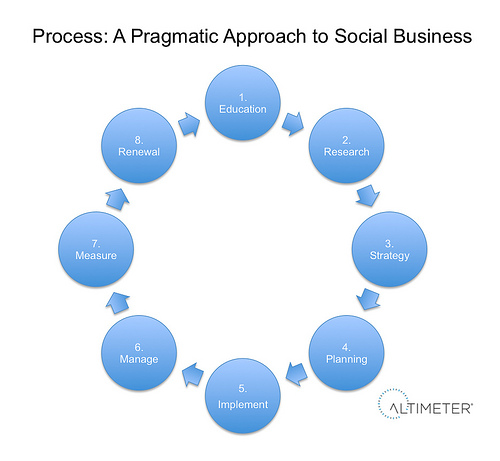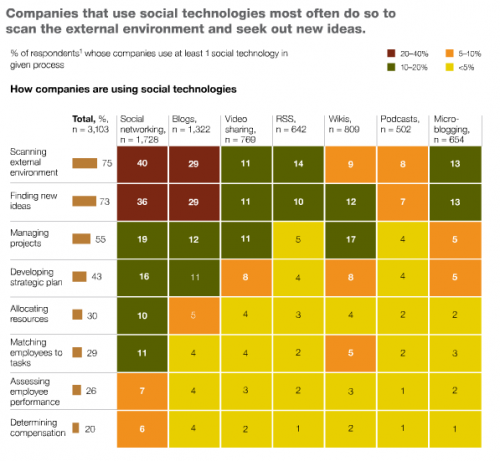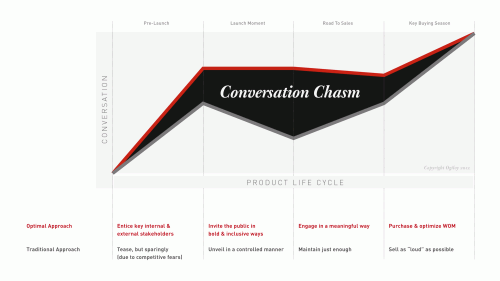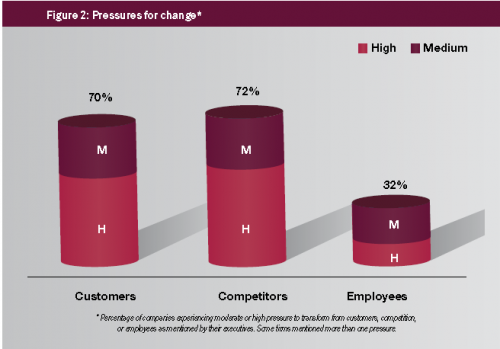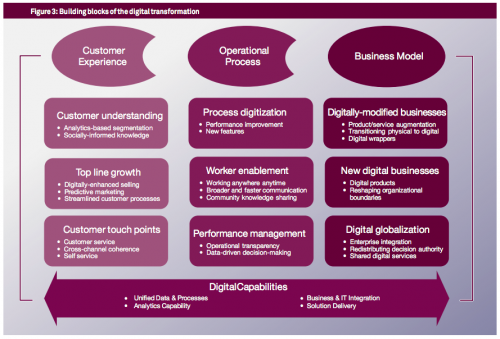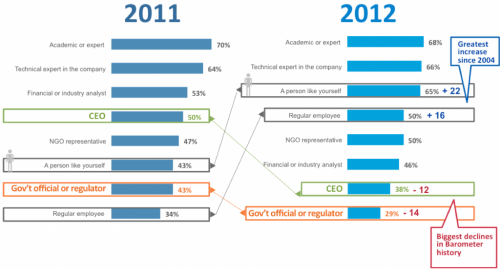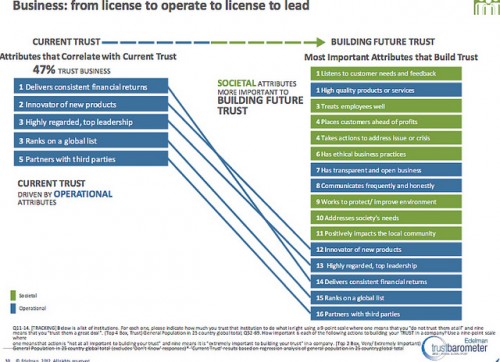We Are Social’s Social Business notes #3
Welcome to We Are Social’s Social Business notes #3, a review of the best social business thinking from around the web in the last month. Quite a bumper month so worth saving this for a well earned coffee break.
Owyang’s approach to social business
I for one always enjoy a good framework and we’ve got two to share this month, first up from Jeremiah Owyang, who has shared his pragmatic approach to social business, have a read of the post for further info on each stage:
Social program development
Jed Singer has shared his five steps for social program development, a great resource for what you should be doing and looking for when planning activity. Do read the post but here is the (lightly edited) condensed version:
- Define your business objective(s)
- Translate those objective(s) to social
- Collate & categorise past social programs
- Analyse past social programs for success and failure against KPIs
- Use analysis & objectives to create a concept calendar (using the program identity design framework)
Social intranets bring big gains
A recent white paper from AIIM highlights some specific gains for organisations that network internally, with “more than 60% of firms who did invest in collaborative frameworks achieving big gains in knowledge sharing and communication accuracy between marketing and sales.”
Social technologies spur user participation and speed up innovation
McKinseys most recent report into how business are using social technologies found that ‘scanning the external environment’ and ‘finding new ideas’ where the most frequently cited use cases:
The conversation chasm
Ian Sohn has posted a well constructed update to a traditional product launch roadmap, neatly showing whats to lose by not including social in your campaigns (hint – its the conversation chasm);
CapGemini pivots consultancy offering to digital transformation
CapGemini have repositioned their entire management consulting practice around social business following a joint research project with MITs Sloan school of management. The report interviewed 160 executives around the world and found that digital transformation was high on the agenda as pressure from customers and competitors drives the need for change. Interestingly pressure from employees was considerably less (perhaps indicative of their relative value at the executive level?)
Later in the report, CapGemini also shared their framework for digital transformation and included a range of benefits & changes within three buckets: customer experience, operational process and business model. Its a great distillation of the business benefits of digital/social and is worth a read to see what else your organisation could be doing:
Trust in CEOs falls of a cliff, trust in regular people shores
Edelman’s latest trust barometer has come back with some stunning changes, with trust in CEOs failing off a cliff and trust surging in ‘a person like me’ or ‘a regular employee’. This now leaves your most trusted organisational spokespeople, in order, as a ‘technical expert’, ‘person like me’ and ‘regular employee’, with the CEO proping up the bottom of the rankings.
No single piece of data has made a more compelling case for social business.
In a world where employees, whether technical experts or regular folks, are a company’s most credible spokespeople, every business simply must understand how to organize and empower employees to interact successfully in social media.
Trust will come from people excellence, not operational excellence
Influxinsights highlight what the report shows about what organisations need to do to gain trust now and in the future, with a shift away from operational attributes to people focused attributes:
Companies need to find the right social media channels and platforms to connect with consumers in order to genuinely solicit their input and demonstrate and update customers on how this input is being used, but also to find ways to bring the people behind the company and the humanity of the business to life in a real and transparent manner.
2012 social business predictions (continued)
Charlene Li started the new year with her three actionable predications for 2012:
- Prediction #1: Consumers will reward transparent companies with their loyalty – Companies must get courageous with transparency and make it an every day occurrence. Or they will face the wrath of outraged customers.
- Prediction #2: Your customers want to be known – Your customers don’t merely want you to understand their needs or pain points. They want you to know them as individuals anywhere and anytime they engage with you.
- Prediction #3: Connected leaders and employees will create sustained competitive advantages through a culture of sharing – This year will see some companies pull ahead of others because they are able to collaborate, innovate and execute better and faster thanks to an ingrained culture of sharing.
John Bell delivered part four of his social business predictions, “social selling as a service”, which two recommendations for organisations this year “By 2nd Q it will be key to be executing on a content marketing strategy that embeds social components. By 4thQ, it would be terrific to have a social utility or buyer service in place being used and tested”.
Forbes collated a series of CMO predications that centred around the impact of an increasingly networked customer base on brand communication. Perhaps our favourite was from Miki Berardelli, CMO at womens fashion brand Tory Burch, who highlights the divide between those that “focus heavily on their competition versus those that focus on their customer while maintaining and strengthening their brand identity”.
Marketing Week and the recruitment firm Ball & Hoolahan polled 3,357 executives to gauge industry attitudes and predictions regarding the next 12 months. Some 53% of the panel believed marketing divisions would be remodelled this year, as several challenges – covering everything from the economy to the rise of digital media – make a continuing impact.
This months news in tools and platforms
Enterprise cloud powerhouse Salesforce has launched Desk.com, providing small-to-medium-sized companies with cloud-based customer support management to help for support through phone, e-mail, web, Twitter, and Facebook. The tool is the evolution of Assistly, which Salesforce acquired last year, with all clients being transfered over to the new platform.
Michael Brito had a glance at Fancorps this month:
a customer advocacy platform which enables organizations to activate and reward customers for word of mouth recommendations and reviews – essentially transforming them from a friend, fan or follower to an advocate
It looks like a great tool for managing larger scale advocacy programmes.
Early in January Altimeter shared their latest research into social media management systems, worth reading the full report if you had time but for the time short we singled out some of the key information on the we are social blog.
IBM has frequently been billed as the enterprise Facebook, and a piece in the New York Times interviews the head of the Connections division. Their success has not gone unnoticed and IBMs status as social business leaders is widely cited, even if they themselves appreciate the growth is business catching up with consumer and employee demand and not the other way round.
Collated thoughts on enterprise social network adoption
Everyone’s a fan of a good ‘top 10’ and David Carr has collated a well put together set on the barriers to adoption for enterprise social networking. All of them are worth your attention and consideration, but perhaps our favourite two point out two of the biggest human challenges from top down and bottom up:
- Command-and-control culture – Lots of moderately conservative organizations will think twice–and maybe rightly so–about whether an internal social network makes sense for their corporate culture.
- Optional vs mandated – Voluntary adoption is probably the right approach. If social software really is so wonderful, employees ought to gravitate to it naturally, as something that makes their lives easier.
The post reads well side by side with Eric Lundquists 10 ways to transform into a social enterprise. These form more a set of strategic ideas to use when working towards becoming a social business, perhaps two of the most pertinent are:
- Think of the social enterprise as a core competency, not an add-on – You have to align with the core values of the company. Treating social as something that takes place in human resources or marketing will doom the project to inactivity.
- Don’t bet on immediate ROI – McKinsey’s research into the social business has surfaced a whole range of business benefits, but those are often not immediately quantifiable from a project’s outset.
By empowering store managers to take more-independent initiative, while also encouraging them to collaborate with their peers across the nation, grocery chain SuperValu has found enterprise social networking in the cloud valuable as a unifying force. Adoption was “a weird story, a combination of a top-down push and a grassroots effort coming together”, where after doing a quick audit of alternative solutions they jumped right in as some employees were already using Yammer with success. One of their key take aways as to why the program succeed was that adoption was initially bottom up, highlighting that lockdown desktops could be limiting your organisations innovation potential.
A recent Gartner blog post from Craig Roth highlights the struggle when IT teams seem not to bother talking to the rest of the organisation before deciding on a organisation wide collaboration platform. He goes on to share six steps they commonly follow for adoption:
- Product selection – A technology may start with a formal product selection step, such as through the purchasing department or an RFP.
- End user decision to use – But purchasing and licensing have little to do with whether a technology will be used. There are several options for how a user will decide to use a technology, influenced by where they are on the governance spectrum, from formal standards to guidance to users bringing it in from home without IT even involved.
- Promotion – Regardless of the route that end users take to deciding (or being compelled) to use the technology, there were many stories about how people knew what to do with it and when to use it. These ranged from event-style rollouts to formal training to more informal mentoring approaches.
- Adoption – All this led to either lots of adoption, failure (usually lost momentum), or a limbo state where there is spotty adoption and a decision needs to be made whether to take another go at increasing usage or just accept where it’s at.
- Resurrection – Technologies don’t really die if not adopted – they may just lie dormant and be re-introduced in a few years when the technology improves, is reborn under a catchier name, or people that were preventing it move out of the way.
- Value – The ultimate goal shouldn’t be adoption (except through the narrow lens of a technology owner getting reviewed on ‘success’) – it should be the value it provides to the business. There were too few participants that discussed value in our unguided interviews.
Employee social network usage on corporate networks triples in a year
Meanwhile, PaloAlto Networks latest research shows a 300% jump in use of social networks like Facebook inside the firewall. The report also higlights a huge jump in the use of Twitter (700% year on year growth) and almost ubiquitous browser file sharing (92% of organisations surveyed). Palo Alto Networks’ René Bonvanie:
Whether or not employees are using social networks or sharing files at work is no longer a question; this data clearly demonstrates that users are embracing and actively using such applications
Social media crisises – lessons from the month
There’s been a range of crisis insights shared this month. Firstly from the Super Bowl, and with a planning hat on, four key thoughts:
understand that their will be a large amount of social media interaction, use computer tools to help monitor, plan for the necessary infrastructure, plan for a big monitoring team, even if you have computer analytics.
Next up Ant’s Eye View share some missteps from Zappos during a recent crisis:
the form of standard communication was changed, key information was not discoverable, poor cross channel planning.
And finally some insights on social media for crisis response – this time recounting a simulation exercise and the assumptions that failed under stress – namely that you will continually need 2-3 people on a large crisis and crisis response is a hugely energy depleting exercise, you’ll need to rotate your staff.
The future of LinkedIn and recruitment
No one can doubt the impact LinkedIn has had on the recruitment business, and this article asks some interesting questions about the potential ramifications:
Will LinkedIn eventually be responsible for driving the average career length of employees down? Is this a bad thing? Or does it put the onus back on companies to up their employee retention efforts? Will we see companies trying to protect themselves by banning them from having a LinkedIn profile that states the company name? Or will we see an upturn in retribution efforts if employees find out about staff job seeking?
This month has seen at least one executive fired for ‘misuse’ of LinkedIn, with the offending content being a ticked interest in ‘career opportunities’.
Financial firm enables staff use of social
Wedbush Securities, a privately held financial services and investment firm based in USA, has announced that they will enable firm wide social media adoption. In a risk adverse industry this is a bold move and its worth noting the approach they’re taking: all staff get trained on the appropriate use of social media in a financial services context, they can only use ‘the big three’ platforms, separate professional accounts will be created for all Wedbush activities.
Employee engagement linked to shareholder value
Harvard Business Review have analysed the link between employee happiness and shareholder value, concluding that the strong link is when employees are enabled to achieve great things within overall aims of the organisation. They suggest three changes to employee engagement process: true ownership by line managers, simpler & more frequent measurement, direct feedback from customers.
Governance maintains focus when passion diminishes
Sean McDonald discussed social business process development within the frame of diminishing passion, an important topic as the team and stakeholders involved in the initiation of a new process will inevitably stop being so for one reason or another. They prescribe governance to ensure compliance & tension beyond passions life cycle, highlighting the need for frequent auditing and updating.
Pepsi enables internal newsletters to be shared externally
PepsiCo have made a lovely little change within their internal comms to encourage their employees to build awareness of the brand amongst their personal networks. Looking for ways of building internal advocates they analysed one newsletter to find 85% of the content would be ok for external eyes; following a bit of digital rejigging it is now optimised for social sharing amongst employees’ networks.
Even Facebook’s employees need training in order to adopt social business
Facebook’s Kathleen Pedersen describes some of their experiences trying to drive adoption of social & analytical tools within Facebook. Traveling to a regional sales office she found that the local staff complained about not having access to the data they needed. After a little probing she found they had built negative assumptions around the actual source to the data they required, a program of education and learning helped connect the dots.
Death of email with Luis Suarez at IBM
Another month, another imaginary nail in email’s coffin, this time a look at Luis Suarez from IBM who hasn’t sent an email for four years, always replying to contacts via social tools. The article goes on to repeat the debate on the death of email, with a unique positive for Suarez being he’s lost 50 pounds since binning the inbox.
The rise of the new Groupthink and the quiet power of the introvert
When this went round a month or so back it was interesting, nay encouraging, to see how well received the ideas were. Perhaps not especially ‘social business’ but for anyone in the business of building organisations it would be wise to consider that not everyone is an extrovert yet many business activities are set up with them in mind – the review here discusses the traditional brainstorm
That’s it for this month – check back again in early March for a more timely round-up of February’s social business thinking
